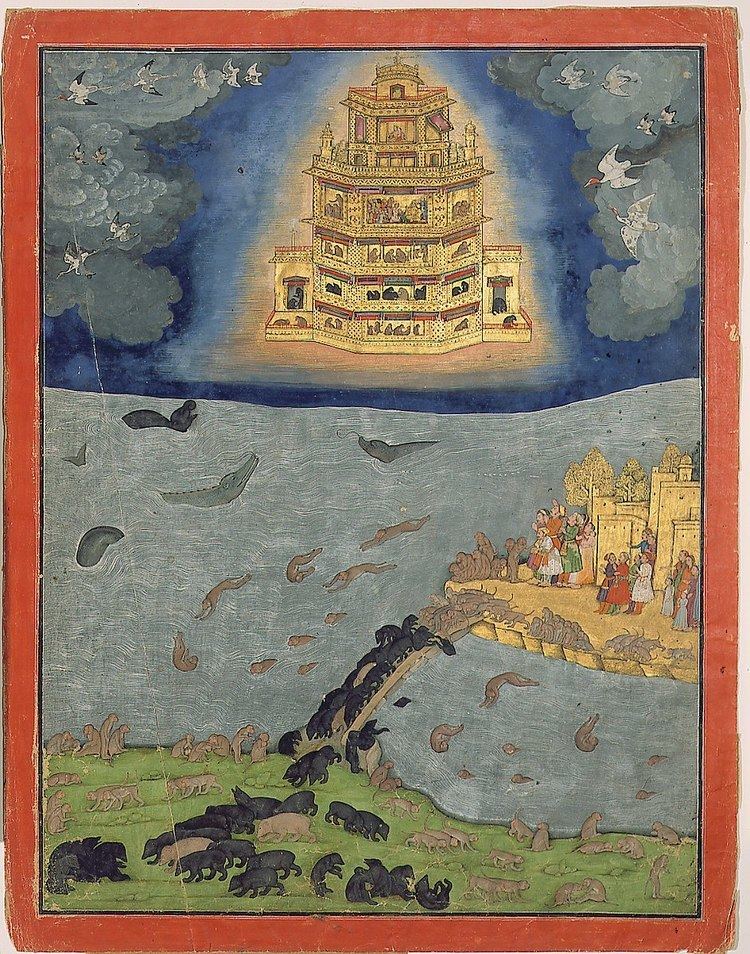 | ||
Vimāna is a mythological flying palace or chariot described in Hindu texts and Sanskrit epics. The Pushpaka Vimana of the demon king Ravana (which was taken from Lord Kubera, and returned to him by Rama) is the most quoted example of a vimana. Vimanas are also mentioned in Jain texts.
Contents
Etymology
The Sanskrit word vi-māna (विमान) literally means "measuring out, traversing" or "having been measured out". Monier Monier-Williams defines Vimana as "a car or a chariot of the gods, any mythical self-moving aerial car sometimes serving as a seat or throne, sometimes self-moving and carrying its occupant through the air; other descriptions make the Vimana more like a house or palace, and one kind is said to be seven stories high", and quotes the Pushpaka Vimana of Ravana as an example. It may denote any car or vehicle, especially a bier or a ship as well as a palace of an emperor, especially with seven stories. In some modern Indian languages like Telugu, Hindi, vimana means "aircraft", for example in the town name Vimanapura (a suburb of Bangalore) and Vimannagar, a town in Pune. In another context, Vimana is a feature in Hindu temple architecture.
Vedas
The predecessors of the flying vimanas of the Sanskrit epics are the flying chariots employed by various gods in the Vedas: the Sun (see Sun chariot) and Indra and several other Vedic deities are transported by flying wheeled chariots pulled by animals, usually horses.
The existing Rigveda versions do not mention Vimanas, but verses RV 1.164.47-48 have been taken as evidence for the idea of "mechanical birds":
47. kṛṣṇáṃ niyânaṃ hárayaḥ suparṇâ / apó vásānā dívam út patantitá âvavṛtran sádanād ṛtásyâd / íd ghṛténa pṛthivî vy ùdyate48. dvâdaśa pradháyaś cakrám ékaṃ / trîṇi nábhyāni ká u tác ciketatásmin sākáṃ triśatâ ná śaṅkávo / 'rpitâḥ ṣaṣṭír ná calācalâsaḥ"Dark the descent: the birds are golden-coloured; up to the heaven they fly robed in the waters.Again descend they from the seat of Order, and all the earth is moistened with their fatness.""Twelve are the fellies, and the wheel is single; three are the naves. What man hath understood it?Therein are set together spokes three hundred and sixty, which in nowise can be loosened." ("trans." Griffith)Swami Dayananda Saraswati interpreted these verses to mean:
"jumping into space speedily with a craft using fire and water ... containing twelve stamghas (pillars), one wheel, three machines, 300 pivots, and 60 instruments."Ramayana
In the Ramayana, the pushpaka ("flowery") vimana of Ravana is described as follows:
"The Pushpaka Vimana that resembles the Sun and belongs to my brother was brought by the powerful Ravana; that aerial and excellent Vimana going everywhere at will ... that chariot resembling a bright cloud in the sky ... and the King [Rama] got in, and the excellent chariot at the command of the Raghira, rose up into the higher atmosphere.'"It is the first flying vimana mentioned in existing Hindu mythology texts (as distinct from the gods' flying horse-drawn chariots). Pushpaka was originally made by Vishwakarma for Brahma, the Hindu god of creation; later Brahma gave it to Kubera, the God of wealth; but it was later stolen, along with Lanka, by his half-brother, king Ravana.
Jain literature
Vimāna-vāsin ('dweller in vimāna') is a class of deities who served the tīrthaṃkara Mahā-vīra. These Vaimānika deities dwell in the Ūrdhva Loka heavens. According to the Kalpa Sūtra of Bhadra-bāhu, the 24th tīrthaṃkara Mahā-vīra himself emerged from the great vimāna Puṣpa-uttara; whereas the 22nd tīrthaṃkara Ariṣṭa-nemi emerged from the great vimāna Aparijita. The tīrthaṃkara-s Abhinandana (4th) and Sumati-nātha (5th) both traveled through the sky in the "Jayanta-vimāna", namely the great vimāna Sarva-artha-siddhi, which was owned by the Jayanta deities; whereas the tīrthaṃkara Dharma-nātha (15th) traveled through the sky in the "Vijaya-vimāna". A vimāna may be seen in a dream, such as the nalinī-gulma.
Vaimānika Shāstra
The Vaimānika Shāstra is an early 20th-century Sanskrit text on aeronautics, obtained allegedly by mental channeling, about the construction of vimānas, the "chariots of the Gods". The existence of the text was revealed in 1952 by G. R. Josyer, according to whom it was written by one Pandit Subbaraya Shastry, who dictated it in 1918–1923. A Hindi translation was published in 1959, the Sanskrit text with an English translation in 1973. It has 3000 shlokas in 8 chapters. Subbaraya Shastry allegedly stated that the content was dictated to him by Maharishi Bharadvaja (who is believed to have lived at least 10,000 years ago). A study by aeronautical and mechanical engineering at Indian Institute of Science, Bangalore in 1974 concluded that the aircraft described in the text were "poor concoctions" and that the author showed a complete lack of understanding of aeronautics.
In popular culture
Vimanas have appeared in books, films, internet and games including:
